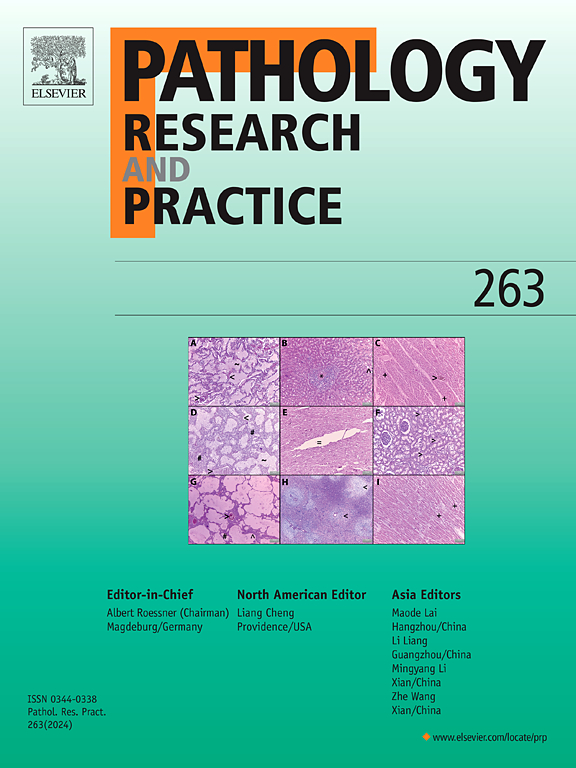阴茎癌中的 GSTM1 和 GSTT1 缺失与 TNM 分期有关,但与 HPV DNA 状态无关
IF 2.9
4区 医学
Q2 PATHOLOGY
引用次数: 0
摘要
GSTT1 和 GSTM1 基因缺失与化学致癌和膀胱癌等泌尿生殖系统恶性肿瘤有关,它们与肿瘤侵袭性增加有关。在子宫颈病变中,GSTT1 和 GSTM1 基因缺失也被认为有助于人类乳头瘤病毒(HPV)感染的持续存在和 HPV 诱导的癌变。阴茎癌是一种罕见的恶性肿瘤,有HPV+和HPV-两种亚型,本研究提出的假设是,GSTT1/GSTM1缺失与HPV DNA的存在和阴茎癌的侵袭性有关。研究人员分析了HPV+和HPV-阴茎癌患者的肿瘤DNA样本和医疗记录。利用 PCR 技术对每个样本进行了 GSTT1 和 GSTM1 缺失以及 HPV DNA 的筛查。74.5% 的样本含有 HPV DNA。61.8%的病例显示为T2和T3分期。HPV+和HPV-病例的GSTT1/GSTM1基因型频率没有差异(p>0.05)。与其他基因型相比,GSTT1wt/GSTMnull 患者的 TNM 分期更高(p=0.012),但在神经周围侵犯和淋巴管侵犯方面未观察到差异。这些发现表明,GSTT1和GSTM1缺失在HPV+和HPV-阴茎癌中很常见。在野生型 GSTT1 存在的情况下,GSTM1 缺失似乎与肿瘤进展有关,因此有必要进行更多的研究来证实其作为阴茎癌预后标志物的潜力。本文章由计算机程序翻译,如有差异,请以英文原文为准。
GSTM1 and GSTT1 deletions in penile cancer are associated with TNM stage but not with HPV DNA status
Deletions of the GSTT1 and GSTM1 are associated with chemical carcinogenesis and genitourinary malignancies like bladder cancer, where they correlate with increased tumor aggressiveness. In uterine cervical lesions, GSTT1 and GSTM1 deletions have also been suggested to facilitate the persistence of human papillomavirus (HPV) infection and HPV-induced carcinogenesis. This work addresses the hypothesis that GSTT1/GSTM1 deletions are associated with presence of HPV DNA and aggressiveness in penile cancer, a rare malignancy with HPV+ and HPV- subtypes. Tumor DNA samples and medical records from HPV+ and HPV- penile cancer patients were analyzed. Each sample was screened for GSTT1 and GSTM1 deletions and for the presence of HPV DNA using PCR-based techniques. 74.5 % of samples contained HPV DNA. 61.8 % of cases showed T2 and T3 staging. There were no differences in the frequencies of GSTT1/GSTM1 genotypes between HPV+ and HPV- cases (p>0.05). GSTT1wt/GSTMnull patients were more likely to have higher TNM stages compared with other genotypes (p=0.012), but no differences were observed concerning perineural invasion nor lymphovascular invasion. These findings indicate that GSTT1 and GSTM1 deletions are common in HPV+ and HPV- penile cancers. GSTM1 deletions in the presence of wild-type GSTT1 seems to be associated with tumor progression, and additional studies are warranted to confirm its potential as a prognostic marker in penile cancer.
求助全文
通过发布文献求助,成功后即可免费获取论文全文。
去求助
来源期刊
CiteScore
5.00
自引率
3.60%
发文量
405
审稿时长
24 days
期刊介绍:
Pathology, Research and Practice provides accessible coverage of the most recent developments across the entire field of pathology: Reviews focus on recent progress in pathology, while Comments look at interesting current problems and at hypotheses for future developments in pathology. Original Papers present novel findings on all aspects of general, anatomic and molecular pathology. Rapid Communications inform readers on preliminary findings that may be relevant for further studies and need to be communicated quickly. Teaching Cases look at new aspects or special diagnostic problems of diseases and at case reports relevant for the pathologist''s practice.

 求助内容:
求助内容: 应助结果提醒方式:
应助结果提醒方式:


